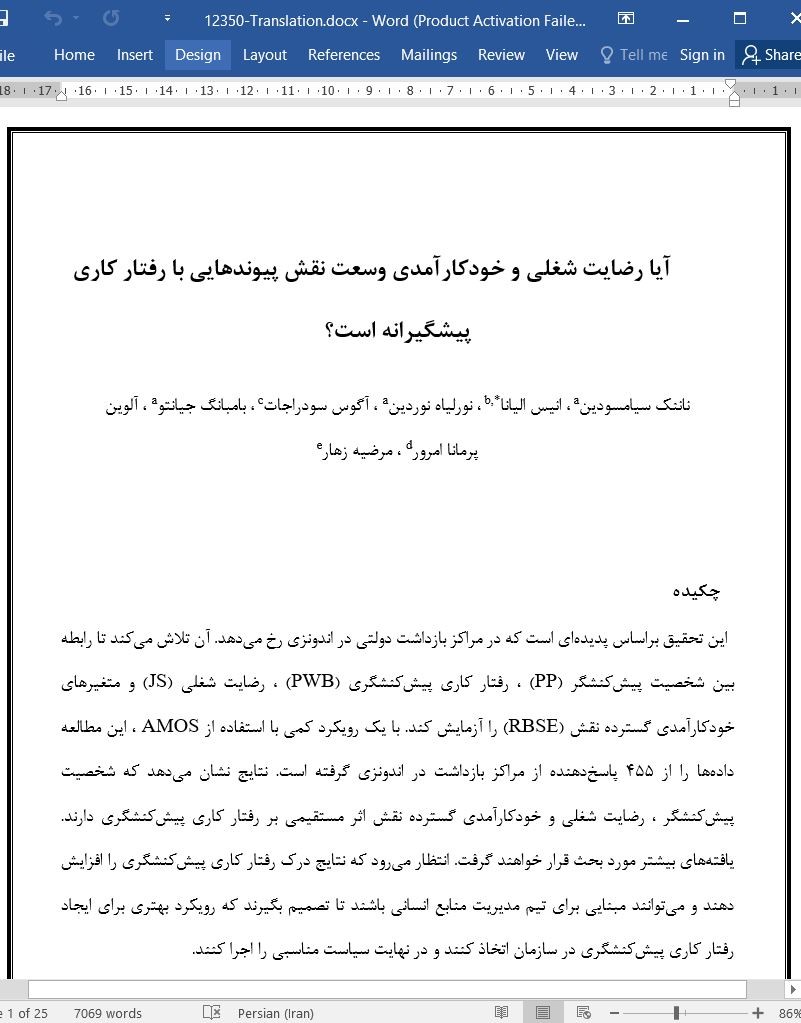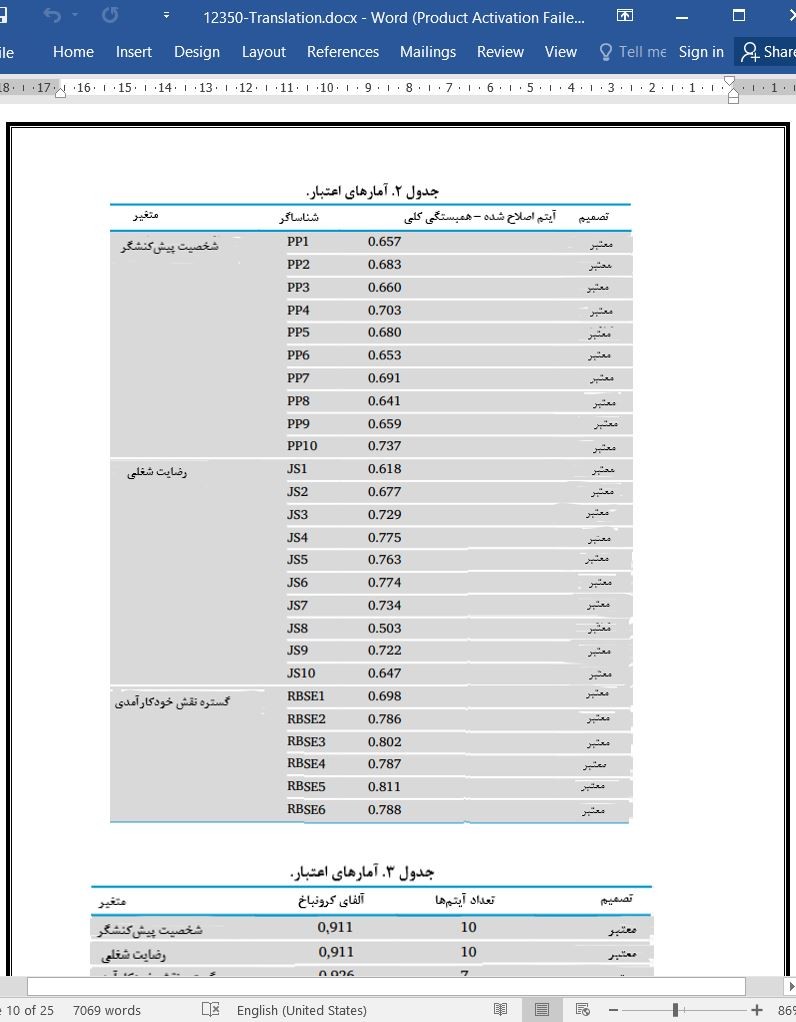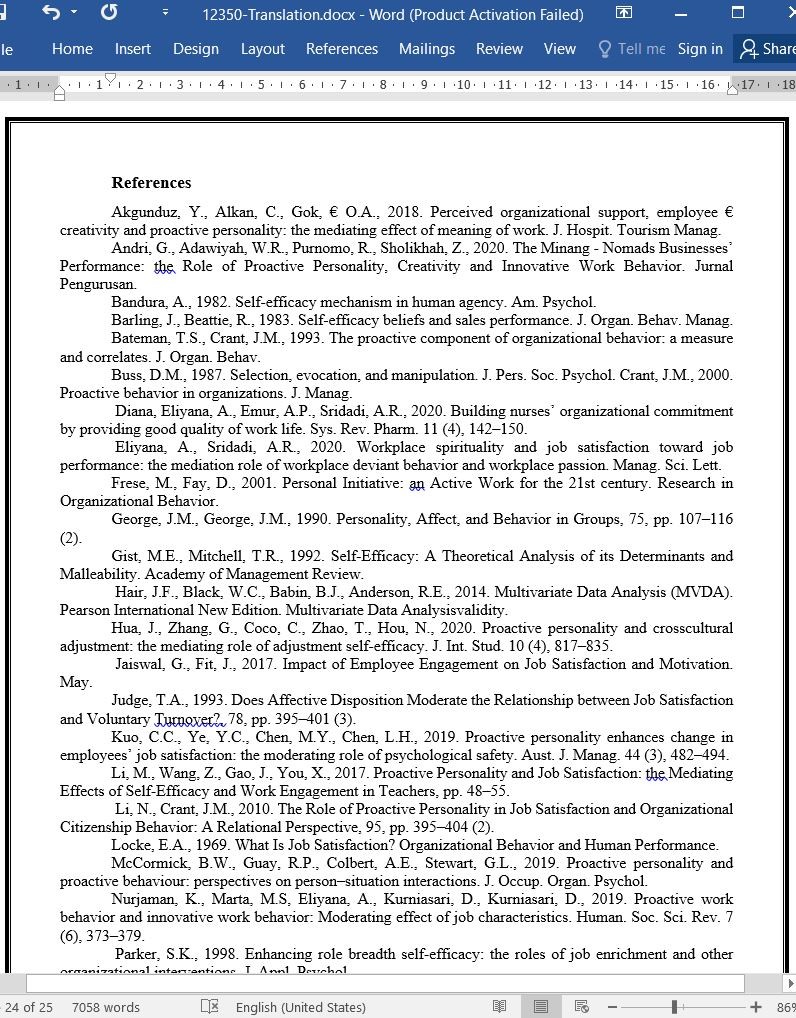
آیا رضایت شغلی و خودکارآمدی وسعت نقش پیوندهایی با رفتار کاری پیشگیرانه است؟
چکیده
این تحقیق براساس پدیدهای است که در مراکز بازداشت دولتی در اندونزی رخ میدهد. آن تلاش میکند تا رابطه بین شخصیت پیشکنشگر (PP) ، رفتار کاری پیشکنشگری (PWB) ، رضایت شغلی (JS) و متغیرهای خودکارآمدی گسترده نقش (RBSE) را آزمایش کند. با یک رویکرد کمی با استفاده از AMOS ، این مطالعه دادهها را از ۴۵۵ پاسخدهنده از مراکز بازداشت در اندونزی گرفته است. نتایج نشان میدهد که شخصیت پیشکنشگر ، رضایت شغلی و خودکارآمدی گسترده نقش اثر مستقیمی بر رفتار کاری پیشکنشگری دارند. یافتههای بیشتر مورد بحث قرار خواهند گرفت. انتظار میرود که نتایج درک رفتار کاری پیشکنشگری را افزایش دهند و میتوانند مبنایی برای تیم مدیریت منابع انسانی باشند تا تصمیم بگیرند که رویکرد بهتری برای ایجاد رفتار کاری پیشکنشگری در سازمان اتخاذ کنند و در نهایت سیاست مناسبی را اجرا کنند.
1 مقدمه
یک مرکز بازداشت ایالتی ، تاسیساتی است که در آن یک مظنون در حالی که پرونده در دادگاه مورد بازجویی ، پیگرد قانونی و بررسی قرار میگیرد ، در بازداشت به سر میبرد. این یک موسسه است که به اعضای جامعه که در زندان به سر میبرند و در عین حال امنیت و نظم را نیز حفظ میکنند ، خدمات ارائه میدهد. در حال حاضر ، جمعیت متوسط مرکز بازداشت دولت در سراسر اندونزی بیش از حد شلوغ است که ضرورت شخصیت پیشکنشگر را در محل کار افزایش میدهد زیرا این بخش مهمی از روند حفظ نظم و امنیت است. این فرآیند شامل حفاظت ، پیشگیری و پیگرد قانونی در برابر هر گونه تهدید و مداخله خارج از مرکز بازداشت دولت میباشد.
6-2 پیشنهاد
چندین پیشنهاد برای بهبود رفتار کاری پیشکنشگری ممکن است براساس یافتهها ارائه شود. کارمندان مراکز بازداشت دولتی اندونزی باید تشویق شوند تا در رفتار کاری پیشکنشگری مشارکت کنند. این به ویژه برای کارکنانی که شخصیت پیشکنشگری دارند درست است. سپس به منظور افزایش رفتار کاری پیشکنشگری ، کارمندان میخواهند احساسات خوبی در ارتباط با رضایت شغلی داشته باشند. به کارمندان شخصیت پیشکنشگری نیز باید اعتماد به نفس داده شود تا نقشهای بیشتری ایفا کنند و در موقعیتهای مناسبی قرار گیرند که رفتار کاری پیشکنشگری را تقویت خواهد کرد. به طور مشابه توسعه و یا ارائه یک شخصیت پیشکنشگری در سایر کارمندان حیاتی است. اتخاذ اقدامات پیشگیرانه در زندانهای دولتی آسانتر خواهد بود. در نتیجه پیشنهاد میشود که افسران مایل به ابتکار عمل و پشتکار در تکمیل مسئولیتهای شغلی به منظور بهبود محیط کاری و مقابله بهتر با مشکلات باشند.
Abstract
This research is based on a phenomenon that occurs in State Detention Centers in Indonesia. It attempts to test the relation among proactive personality (PP), proactive work behavior (PWB), job satisfaction (JS) and role breadth self-efficacy (RBSE) variables. With a quantitative approach using AMOS, this study took data from 455 respondents from Detention Centers in Indonesia. The results show that PP, JS and RBSE have direct effect on PWB. Further findings will be discussed. The results are expected to increase the understanding of PWB and can be the basis for the human resource management team to decide better approach to build PWB in the organization and eventually implement appropriate policy.
1. Introduction
A State Detention Center is a facility where a suspect is held while the case is investigated, prosecuted, and examined in court. It is an institution that provides services to community members who are incarcerated in cells while also preserving security and order. Currently, the average population of State Detention Center throughout Indonesia is overcrowded which increases the urgency of PP in the workplace since it is an integral part of the maintaining order and security process. This process includes providing protection, prevention and prosecution against any threats and interference from outside the State Detention Center
6.2. Suggestion
Several suggestions for improving PWB may be offered based on the findings. Employees at Indonesian State Detention Centers should be encouraged to engage in PWB. This is especially true for employees that have a PP. Then, in order to increase PWB, employees want good sentiments associated to JS. Employees with PP must also be given the confidence to take on greater roles and be placed in appropriate positions, which will foster PWB. Similarly, developing or bringing forth a PP in other employees is critical. Preventative actions in state prisons will be easier to adopt this way. As a result, it is suggested that officers be willing to take initiative and persevere in completing job responsibilities in order to improve the working environment and better deal with problems
چکیده
1 مقدمه
2 مرور ادبیات
2-1 شخصیت پیشکنشگر
2-2 رفتار کاری پیشکنشگر
2-3 رضایت شغلی
2-4 وسعت نقش خودکارآمدی
2-5 شخصیت فعال در رفتار کاری پیشکنشگر
2-6 شخصیت پیشکنشگر در رضایت شغلی
2-7 شخصیت پیشکنشگر در خودکارآمدی وسعت نقش
2-8 رضایت شغلی در رفتار کاری پیشکنشگر
2-9 نقش گسترده خودکارآمدی در رفتار کاری پیشکنشگر
2-10 نقش واسطه رضایت شغلی
2-11 نقش واسطه خودکارآمدی وسعت نقش
3 روشها
4 نتایج
4-1 مروری بر اعتبار و قابلیت اطمینان
4-2 اعتبار سازه
4-3 اعتبار سازه
4-4 تناسب مدل ساختاری
4-5 (آمار) مجذور کای
4-6 مربع هنج دار کای (Cmin / Df)
4-7 شاخص تناسب خوب (GFI)
4-8 خطای جذر میانگین مربعات تقریب (RMSEA)
4-9 باقیمانده میانگین ریشه استاندارد شده (SRMR)
4-10 شاخص تناسب تطبیقی (CFI)
4-11 شاخص تاکر لوئیس (Tli)
4-12 شاخص برازش استاندارد شده (NFI)
4-13 شاخص تناسب نسبی (RFI)
4-14 شاخص نیکویی برازش تعدیلشده (AGFI)
4-15 شاخص برازش هنج دار شده پارسیمونی (PNFI)
4-16 آزمایش فرضیه
4-16-1 آزمایش روابط ساختاری (اثر مستقیم)
4-16-2 آزمایش روابط ساختاری (اثر غیرمستقیم)
5 بحث
6 نتیجهگیری و پیشنهاد
6-1 جمعبندی
6-2 پیشنهاد
منابع
ABSTRACT
1. Introduction
2. Literature review
2.1. Proactive personality
2.2. Proactive work behavior
2.3. Job satisfaction
2.4. Role breadth self-efficacy
2.5. Proactive personality on proactive work behavior
2.6. Proactive personality on job satisfaction
2.7. Proactive personality on role breadth self-efficacy
2.8. Job satisfaction on proactive work behavior
2.9. Role breadth self-efficacy on proactive work behavior
2.10. Mediating role of job satisfaction
2.11. Mediating role of role breadth self-efficacy
3. Methods
4. Results
4.1. An overview of the validity and reliability
4.2. Construct validity
4.3. Construct reliability
4.4. Structural model fit
4.5. Chi-square
4.6. Normed Chi-square (Cmin/Df)
4.7. Goodness of fit index (GFI)
4.8. Root mean square error of approximation (RMSEA)
4.9. Standardized root mean residual (SRMR)
4.10. Comparative fit index (CFI)
4.11. Tucker Lewis index (TLI)
4.12. Normed fit index (NFI)
4.13. Relative fit index (RFI)
4.14. Adjusted goodness of fit index (AGFI)
4.15. Parsimony normed fit index (PNFI)
4.16. Hypothesis testing
4.16.1. Testing structural relationships (direct effect)
4.16.2. Testing structural relationships (indirect effect)
5. Discussion
6. Conclusion and suggestion
6.1. Conclusion
6.2. Suggestion
References
- اصل مقاله انگلیسی با فرمت ورد (word) با قابلیت ویرایش
- ترجمه فارسی مقاله با فرمت ورد (word) با قابلیت ویرایش، بدون آرم سایت ای ترجمه
- ترجمه فارسی مقاله با فرمت pdf، بدون آرم سایت ای ترجمه



